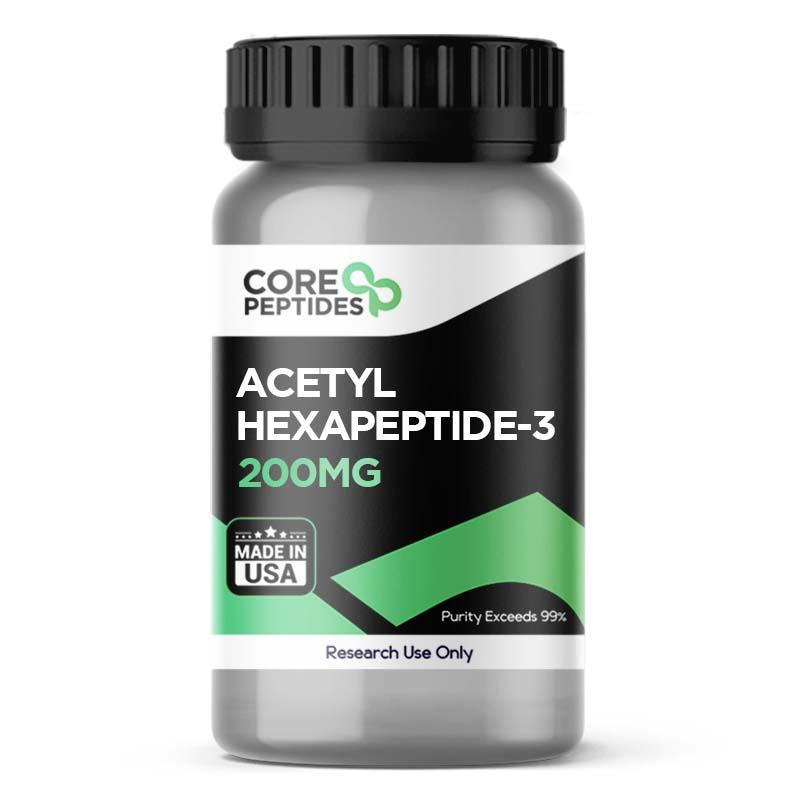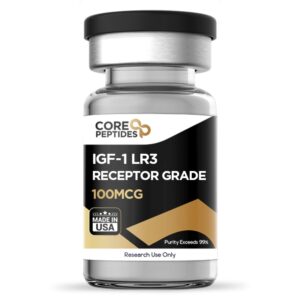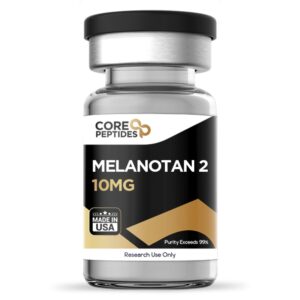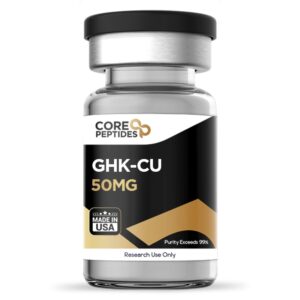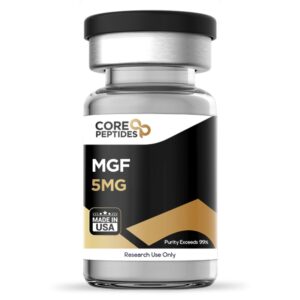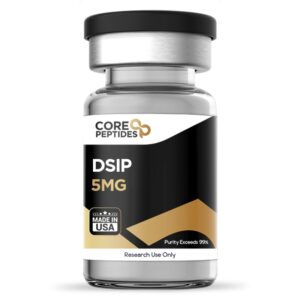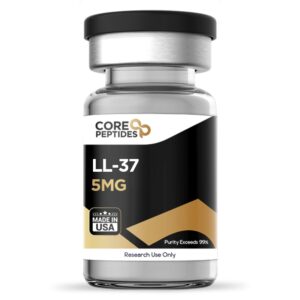Acetyl Hexapeptide-3 (Argireline) (200mg)
$226.00
Size: 200mg
Contents: Acetyl Hexapeptide-3 (Argireline)
Form: Lyophilized powder
Purity: >99%
SKU: P-ACETYL-HEXAPEPTIDE-3
FREE Shipping on $200+ orders
Discount per Quantity
| Quantity | Discount | Price |
|---|---|---|
| 5 - 8 | 5% | $214.70 |
| 9 + | 10% | $203.40 |
Acetyl Hexapeptide-3
Acetyl Hexapeptide-3 is a synthetic peptide commonly researched for its potential action in reducing wrinkle formation in skin tissues. Researchers developed Acetyl Hexapeptide-3 as a competitive SNAP25 (synaptosome-associated protein 25 kDa) inhibitor. SNAP-25 is a component of the SNARE (soluble N-ethylmaleimide sensitive factor attachment protein receptor) complex, which is posited to be a central regulator of synaptic vesicle Ca(2+)-dependent exocytosis - a key process in the release of signaling molecules and cellular communication. This inhibition is thought to occur due to the apparent similarity between the amino acid sequence pattern from the N-terminal end of SNAP-25 and Acetyl Hexapeptide-3. This is hypothesized to prevent the formation of the SNARE complex and inhibit the exocytosis of messengers. By apparently inhibiting exocytosis, Acetyl Hexapeptide-3 may potentially block the release of acetylcholine, a neurotransmitter involved in muscle contractions that mediates the communication between nerve and muscle cells.
Conducting research with Acetyl Hexapeptide-3 is considered a milder and less invasive alternative to bacterial toxins because the peptide may have the potential to act directly through the skin tissues and reach any superficially underlying muscle cells.(2) The peptide may also have research applications in other areas related to skin tissue and muscle tissue studies, such as collagen synthesis, muscle spasms, and scarring. Furthermore, palmitoylated peptide versions have been posited to block the function of pain-mediating neurons.
Chemical Makeup
Molecular formula: C34H60N14O12S
Molecular weight: 888.99 g/mol
Other known titles: Acetyl Hexapeptide-8, Argireline
Research and Clinical Studies
Acetyl Hexapeptide-3 and Wrinkles
Acetyl Hexapeptide-3 was apparently designed to mimic the action of BoNTs while passing through the skin layers. One study suggested that an emulsion containing Hexapeptide led to an apparent reduction in wrinkle depth by up to 30% after 30 days in 10 test subjects.(2)
An additional study investigated the impact of Acetyl Hexapeptide-3 on the skin properties of 24 test subjects and reported similar results.(3) Subjects were randomly assigned to a peptide or placebo group for 60 days. Skin microtopography and transepidermal water loss (TEWL) were estimated at different times throughout the experiment. The authors suggested that Acetyl Hexapeptide-3 had possible anti-wrinkle activity and might decrease TEWL, indicating increased water retention and hydration of the skin tissues. The potential of the peptide does not appear to depend on the type of skin model.
Further data has also posed similar findings. For example, another clinical study that involved 52 test subjects was conducted over 29 days to evaluate the potential impact of Acetyl Hexapeptide-3 in wrinkle improvement.(4) After the study, the scientists observed apparently improved skin wrinkle morphology and skin hydration in all groups.
In another clinical study, the scientists report that compared to the placebo, "the total anti-wrinkle efficiency …] was 48.9%, the depth of the wrinkles was notably reduced" in the Acetyl Hexapeptide-3 group.(5)
Experiments with murine models suggest that Acetyl Hexapeptide-3 may help improve wrinkles and fine lines by interacting with collagen synthesis, although this mechanism is poorly studied. For example, one study in aged murine models which were given the peptide for six weeks exhibited an apparent improvement in the histological structure of the skin tissue, with an increase in type I collagen fibers and a decrease in type III collagen fibers.(6) The study concluded that Acetyl Hexapeptide-3 might rejuvenate aging skin tissues through a potential impact on its histological structure.
Acetyl Hexapeptide-3 and Muscle Spasms
Acetyl Hexapeptide-3 has been studied in the context of involuntary muscle spasms, such as blepharospasms, characterized by involuntary contractions of the eyelid muscles. One study investigated the potential of Acetyl Hexapeptide-3 for blepharospasm in a clinical setting.(7) The study involved 24 test subjects with blepharospasm in a double-blind, placebo-controlled, randomized design. The primary outcome measured was the time until the spasm before the experiment returned, and the spasm grade was assessed via the Jankovic Blepharospasm Rating Scale (JBRS). There was a trend for a longer period until the return of the spasm in the active group compared to the placebo group, with an average of 3.7 months versus 3.0 months. Additionally, the active group tended to have better JBRS scores- or a lower grade of blepharospasm- than those in the placebo group. Interestingly, the researchers also report that "One-third (4/12) of the [subjects] in the active group had a considerable extension of symptom control after [neurotoxins] (range: 3.3-7.1 months)."
Acetyl Hexapeptide-3 and Scarring
According to one retrospective study, Acetyl Hexapeptide-3 may support the mitigation of scar tissues, such as the one that may develop following the damage of skin cells.(8) Scientists measured skin tissue quality parameters, took photographs, and performed a clinical assessment before and after the study.(8) This apparent effect on scarring tissues may be due to the aforementioned potential of Acetyl Hexapeptide-3 to minimize the production of collagen type 3 fibers. Collagen type 3 fibers are typical for scar tissues and are identified as having low elasticity and a structure that differentiates from surrounding tissues. Moreover, this was observed as a potential factor that increased the elasticity of regenerating tissues. More specifically, the authors reported that scar tissue elasticity increased "from 33.5% to 40.5%” in certain areas of the skin tissues.
Acetyl Hexapeptide-3 and Pain Perception
Acetyl Hexapeptide-3 has undergone various in vitro examinations to determine its possible effects on cell and molecular activities linked to neurotransmission and pain sensation. For instance, the palmitoylated version of Acetyl Hexapeptide-3, called DD04107, has been studied for its potential analgesic activity in chronic inflammatory and neuropathic pain models.(9) It was suggested to be potentially impactful in blocking the inflammatory recruitment of ion channels and the release of calcitonin gene-related peptides, resulting in anti-hyperalgesia and anti-allodynia. Further, the study purported that the palmitoylated form of Acetyl Hexapeptide-3 might hinder the release of neuromodulators, which are considered crucial to pain-related signaling. This may potentially be achieved by disrupting SNAP-25 activity and blocking the Ca(2+)-dependent release of these neuromodulators. Consequently, this modified form of Acetyl Hexapeptide-3 might prevent the activation of TRPV1 channels, which are involved in inflammatory processes, further showcasing its potential to alleviate hyperalgesia and allodynia. TRPV1 channels, primarily located on sensory nerve fibers responsible for pain perception, are considered to be triggered by various elements such as heat, inflammatory substances, and chemical irritants. Activation of these channels is considered a key step in pain signal generation and transmission.
In another experiment, carrageenan-induced inflammation models were used to simulate acute inflammatory pain, and the palmitoylated Acetyl Hexapeptide-3 has been proposed to exhibit anti-inflammatory effects, through decreased paw swelling (an inflammation indicator) and reduced mechanical sensitivity.(10) Additionally, this peptide's actions have been assessed in chronic inflammatory pain models, like Complete Freund's Adjuvant (CFA)-induced inflammation. CFA-induced inflammation is an experimental method in scientific research to simulate chronic inflammatory conditions in laboratory models, typically murine models. CFA, a complex mixture, contains inactivated and dried mycobacteria, usually Mycobacterium tuberculosis, emulsified in mineral oil. This mixture prompts a robust and persistent inflammatory response. In such models, it has been observed to apparently reduce both thermal hyperalgesia and mechanical allodynia, suggesting its potential in influencing chronic inflammatory pain. The palmitoylated version of Acetyl Hexapeptide-3 is also considered for its potential to alleviate pain linked to peripheral neuropathy caused by various factors. It was reported by the researchers to potentially have a concentration-responsive capability to lessen mechanical hyperalgesia in animal models of such neuropathies.
Acetyl Hexapeptide-3 peptide is available for research and laboratory purposes only. Please review and adhere to our Terms and Conditions before ordering.
References:
- Grosicki, M., Latacz, G., Szopa, A., Cukier, A., & Kieć-Kononowicz, K. (2014). The study of cellular cytotoxicity of argireline - an anti-aging peptide. Acta biochimica Polonica, 61(1), 29–32.
- Blanes-Mira, C., Clemente, J., Jodas, G., Gil, A., Fernández-Ballester, G., Ponsati, B., Gutierrez, L., Pérez-Payá, E., & Ferrer-Montiel, A. (2002). A synthetic hexapeptide (Argireline) with antiwrinkle activity. International journal of cosmetic science, 24(5), 303–310. https://doi.org/10.1046/j.1467-2494.2002.00153.x
- Raikou, V., Varvaresou, A., Panderi, I., & Papageorgiou, E. (2017). The efficacy study of the combination of tripeptide-10-citrulline and acetyl hexapeptide-3. A prospective, randomized controlled study. Journal of cosmetic dermatology, 16(2), 271–278. https://doi.org/10.1111/jocd.12314
- An, J. H., Lee, H. J., Yoon, M. S., & Kim, D. H. (2019). Anti-Wrinkle Efficacy of Cross-Linked Hyaluronic Acid-Based Microneedle Patch with Acetyl Hexapeptide-8 and Epidermal Growth Factor on Korean Skin. Annals of dermatology, 31(3), 263–271. https://doi.org/10.5021/ad.2019.31.3.263
- Wang, Y., Wang, M., Xiao, X. S., Pan, P., Li, P., & Huo, J. (2013). The anti wrinkle efficacy of synthetic hexapeptide (Argireline) in Chinese Subjects. Journal of cosmetic and laser therapy : official publication of the European Society for Laser Dermatology, Advance online publication.
- Wang, Y., Wang, M., Xiao, X. S., Huo, J., & Zhang, W. D. (2013). The anti-wrinkle efficacy of Argireline. Journal of cosmetic and laser therapy : official publication of the European Society for Laser Dermatology, 15(4), 237–241. https://doi.org/10.3109/14764172.2013.769273
- Lungu, C., Considine, E., Zahir, S., Ponsati, B., Arrastia, S., & Hallett, M. (2013). Pilot study of acetyl hexapeptide-8 in the treatment for blepharospasm in patients receiving botulinum toxin therapy. European journal of neurology, 20(3), 515–518. https://doi.org/10.1111/ene.12009
- Palmieri, B., Noviello, A., Corazzari, V., Garelli, A., & Vadala, M. (2020). Skin scars and wrinkles temporary camouflage in dermatology and oncoesthetics: focus on acetyl hexapeptide-8. La Clinica terapeutica, 171(6), e539–e548. https://doi.org/10.7417/CT.2020.2270
- Ponsati, B., Carreño, C., Curto-Reyes, V., Valenzuela, B., Duart, M. J., Van den Nest, W., Cauli, O., Beltran, B., Fernandez, J., Borsini, F., Caprioli, A., Di Serio, S., Veretchy, M., Baamonde, A., Menendez, L., Barros, F., de la Pena, P., Borges, R., Felipo, V., Planells-Cases, R., … Ferrer-Montiel, A. (2012). An inhibitor of neuronal exocytosis (DD04107) displays long-lasting in vivo activity against chronic inflammatory and neuropathic pain. The Journal of pharmacology and experimental therapeutics, 341(3), 634–645. https://doi.org/10.1124/jpet.111.190678
- Butrón, D., Zamora-Carreras, H., Devesa, I., Treviño, M. A., Abian, O., Velázquez-Campoy, A., Bonache, M. Á., Lagartera, L., Martín-Martínez, M., González-Rodríguez, S., Baamonde, A., Fernández-Carvajal, A., Ferrer-Montiel, A., Jiménez, M. Á., & González-Muñiz, R. (2021). DD04107-Derived neuronal exocytosis inhibitor peptides: Evidences for synaptotagmin-1 as a putative target. Bioorganic chemistry, 115, 105231. https://doi.org/10.1016/j.bioorg.2021.105231
